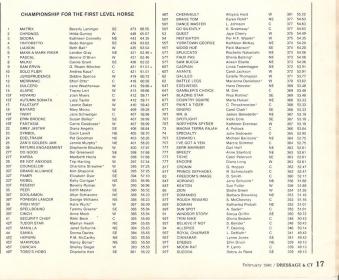Link to YouTube video: https://www.youtube.com/watch?v=JvqQ-xzZYtI
Here are my notes on the talk if anyone is interested. These aren’t comprehensive as I focused on what I found most interesting. It’s mostly not direct quotes but I tried to paraphrase accurately. Janet Foy did most of the speaking so I marked Mike Osinski’s comments with “(MO).”
~20 min, re judge pay in Europe vs US:
In US, judges get paid and have all their expenses paid, so they can make a living as a professional judge
In Europe, judges are not paid
When US FEI judges judge in Europe they are offered a certain amount (ex: $700 or $1200) and have to decide if it’s worthwhile, then must pay their own expenses out of that, including airfare
Due to judging in Europe a lot last year, JF and MO made $20-30k less than usual
~26 min, Q: Is judging less strict now than in the 70s/80s?
Previous system:
- Any one mistake was a 4
- Judges were giving Donnerhall a 6 on gaits
- 60% used to put you on the team
New system:
- Eric Lette took over as FEI Dressage Committee Chair and he was a breeder/trainer/rider more than prior chairs
- He introduced the word “quality”
- What happened before/after a mistake should also be considered rather than just an automatic 4
- Judges have been encouraged to use the full scale more
Reasons for higher scores today:
- Judging is getting better
- Quality of the horses is so much higher
- Riding is getting better
~33 min, Q: Isn’t dressage then turning into a breed show where everything is about the quality of the horses and not so much about the training? Won’t this be bad for non-typical breeds in the GP?
We have to recognize the horse as an athlete
Quality comes first because dressage is an Olympic sport and everybody must be judged the same (there can’t be different judging for people going to the Olympics and people not going to the Olympics)
“Quality of the horse doesn’t matter if the training is not correct”
Quality + Basics + Essence of Movement + Modifiers
Less athletic horse with very good training “probably” will win over very athletic horse with bad training
Movements that reveal training: walk pirouettes (not in GP test anymore), walk, reinback
Specially bred horses will score better but there is a place for the other horses (MO)
~37 min, re new “code of points”:
Plan was to debut it after Tokyo Olympics
Tries to marry “one mistake is a 4” to “quality first”
The idea is that even if the horse is super-high-quality, mistakes will prevent score from being higher than a certain number
Setting out criteria for what constitutes 10, 9, 8, etc
Ex: in the changes, one mistake is 5, two mistakes is 4, three mistakes is 3, four mistakes is 2, etc
That will make the people without as extravagant horses more comfortable because their correct training will have more influence
~48 min: US legal system prohibits fast-tracking of excellent riders/judges up the USEF judge levels
~54 min, re statistics on judges and panel selection:
Statistics are collected on each FEI judge’s scoring to see if their standard deviation and placings are in line with other judges
Judges can log into their dashboard to see their statistics compared to other judges
This is how panels have been selected for championships in the past few years, by selecting judges that “judge well together”, and there have not been any big huge deviations in the last few championships
~57 min: “I think we’re going to die if we stick to the black and white uniforms and ‘this is the way it’s always been done so that’s how we’re going to do it.’ i think we have to become more modern.” Discusses colorwheel. JF favors doing away with coat requirement etc because all that should be judged is the riding.
~59 min, re future of the sport:
We need to develop the children and the ponies. The US sort of started at the top and worked its way down because that’s how we had to do it. Need to get Western and HJ kids into dressage.
There is more harmonious riding because today’s horses are more sensitive
As long as we keep breeding wonderful horses there is hope
~62 min, Q: How do we as riders know what the judges want, the “slow” of the Americans vs the forward of the Europeans?
I think judges disagree on the PSG so much because it’s mostly straight lines so you can have a big-moving horse and kill it except for the pirouettes
There’s a fine line between forward and real training and developing the gaits and quality of collection
We have to be careful not to get into the old German “more forward, more forward, more forward” because that requires more submission and can lead to tension
We want more forward through suppleness, training, and harmony
At the end, you have to collect—you can’t keep running them off their feet, so it takes care of itself (MO)
”‹I think that the new “code of points” sounds intriguing, as far as setting consistent standards for each movement and penalizing poor training even if the horse is a very fancy mover. It will be interesting to learn more about that as it develops.
The discussion of judge pay in Europe vs the US may be interesting to those who ask why it is so much more expensive to show here (one of many factors of course).


 )
)